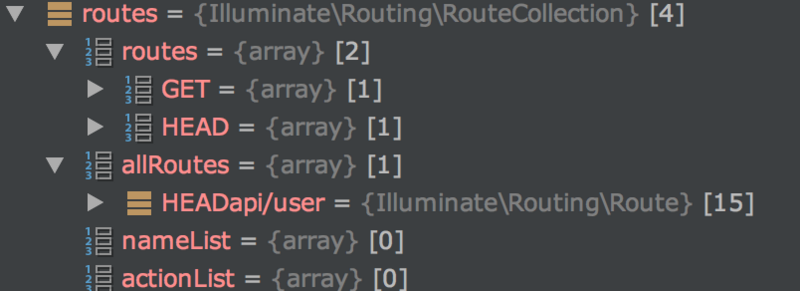前言
我的解析文章并非深层次多领域的解析攻略。但是参考着开发文档看此类文章会让你在日常开发中更上一层楼。
废话不多说,我们开始本章的讲解。
入口
Laravel启动后,会先加载服务提供者、中间件等组件,在查找路由之前因为我们使用的是门面,所以先要查到Route的实体类。
注册
第一步当然还是通过服务提供者,因为这是laravel启动的关键,在 RouteServiceProvider 内加载路由文件。
protected function mapApiRoutes(){ Route::prefix('api') ->middleware('api') ->namespace($this->namespace) // 设置所处命名空间 ->group(base_path('routes/api.php')); //所得路由文件绝对路径}首先require是不可缺少的。因路由文件中没有命名空间。 Illuminate/Routing/Router 下方法
protected function loadRoutes($routes){ if ($routes instanceof Closure) { $routes($this); } else { $router = $this; require $routes; }}随后通过路由找到指定方法,依旧是 Illuminate/Routing/Router 内有你所使用的所有路由相关方法,例如get、post、put、patch等等,他们都调用了统一的方法 addRoute
public function addRoute($methods, $uri, $action){ return $this->routes->add($this->createRoute($methods, $uri, $action));}之后通过 Illuminate/Routing/RouteCollection addToCollections 方法添加到集合中
protected function addToCollections($route){ $domainAndUri = $route->getDomain().$route->uri(); foreach ($route->methods() as $method) { $this->routes[$method][$domainAndUri] = $route; } $this->allRoutes[$method.$domainAndUri] = $route;}添加后的结果如下图所示

实例化
依旧通过反射加载路由指定的控制器,这个时候build的参数$concrete = App/Api/Controllers/XxxController
public function build($concrete){ // If the concrete type is actually a Closure, we will just execute it and // hand back the results of the functions, which allows functions to be // used as resolvers for more fine-tuned resolution of these objects. if ($concrete instanceof Closure) { return $concrete($this, $this->getLastParameterOverride()); } $reflector = new ReflectionClass($concrete); // If the type is not instantiable, the developer is attempting to resolve // an abstract type such as an Interface of Abstract Class and there is // no binding registered for the abstractions so we need to bail out. if (! $reflector->isInstantiable()) { return $this->notInstantiable($concrete); } $this->buildStack[] = $concrete; $constructor = $reflector->getConstructor(); // If there are no constructors, that means there are no dependencies then // we can just resolve the instances of the objects right away, without // resolving any other types or dependencies out of these containers. if (is_null($constructor)) { array_pop($this->buildStack); return new $concrete; } $dependencies = $constructor->getParameters(); // Once we have all the constructor's parameters we can create each of the // dependency instances and then use the reflection instances to make a // new instance of this class, injecting the created dependencies in. $instances = $this->resolveDependencies( $dependencies ); array_pop($this->buildStack); return $reflector->newInstanceArgs($instances);}
新闻热点
疑难解答